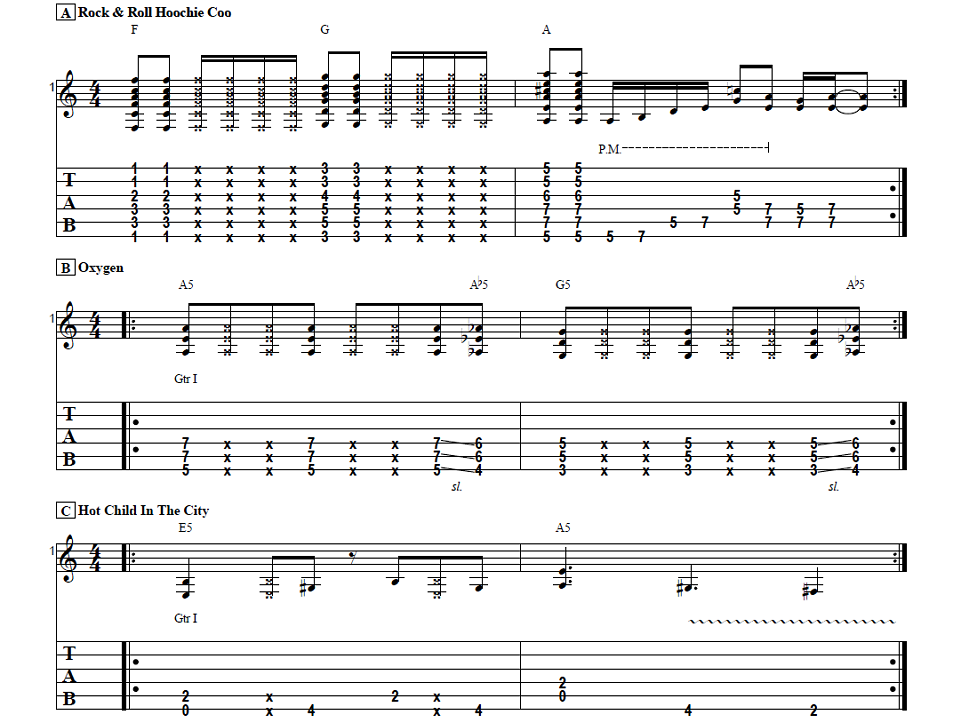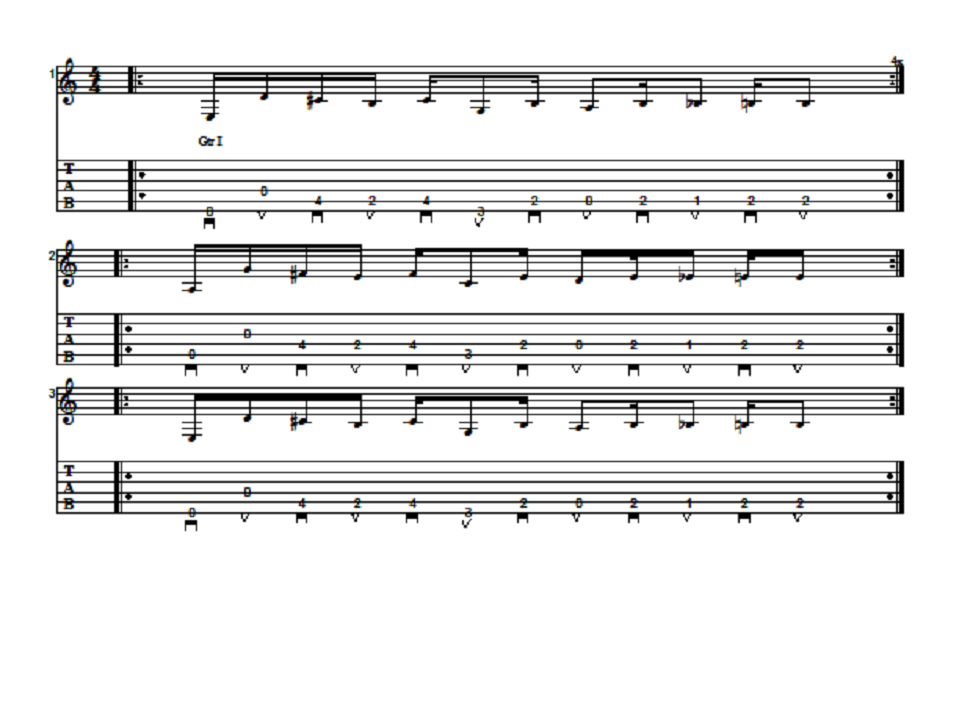Learn to play three more fun and easy riffs from the 1970s volume three with Guitar Control instructor Darrin Goodman, aka Uncle D. Be sure to get the free tabs to go along with the step by step video instruction and you will be rockin’ these classic riffs in record time.

Introduction
How’s it going everybody? This is Darrin with GuitarControl.com bringing this video lesson and today I’ve got a lesson for all the beginners out there; I’ve got three fun really easy riffs to play from the 1970s.
So right now Guitar Control is giving away this really cool free chord chart, there’s a link down the description where you can download yours. It’s in PDF format and just has every chord you could ever need all neatly organized just in one sheet, so it’s really handy. You can download it, print it off, put it where you practice, put a copy in your gig bag, just any situation, whatever chord you have at a glance and it’s a free download.
So be sure to click on the link in the description for the tabs and let’s get close up and take a look at these.
1970s Riff-1 – Rock & Roll Hoochie Coo
All right so the first we’re going to look at is the riff from Rock and Roll Hoochie Coo by Rick Derringer. So for this one we’re going to use a major bar chord shape with the root note on your low E string so if you already know this F it’s that shape we’re just going to move it around. So now for the first one it is F, so what I’m doing is I’m just got my first finger barred all the way across all six strings at the first fret and then my second finger is going on to the second fret of the G string and then my third finger onto the third fret of the A string and my fourth finger on to the third fret of the D string. So we’re going to play this one and so its eighth notes and then we’re going to do some mute strums. So we do the chord one and, and then you just you keep your fingers in the shape, you just release the pressure, so now you’re just touching the strings so that way when we strum we just get that percussive sound. So for beat two it’s just the muted chord, but played as 16th notes; so two and uh. All right and then starting on beat three we’re just going to move this shape up a whole step; so now we’re barring at the third fret, which makes this G major and then your second finger is on the fourth fret of the G string, third finger on the fifth fret of the A string and fourth finger on the fifth fret of the D string and we’re going to do the same thing three and four and… Then starting on the second measure we move it up a whole step again so now it’s A major; so now I’m barring the fifth fret and my middle finger is on the fourth fret of the G string, excuse me, the sixth fret of the G string and my third finger is on the seventh fret of the A string and fourth fingers on the seventh fret of the D string and we do the same thing one and, and then this is where it changes. So now we’ve got this little riff. So we start on the low E string five, so it’s using my first finger, so starting at the fifth fret to the seventh fret and then to the A string fifth fret, seventh fret and this is two e and uh, and then on the downbeat of three we’re going to take our first finger and just barre at the fifth fret across the D and the G string and then take your third finger and barre the seventh fret of the A and the D string. So we hit the five and five on that the D and G string on the downbeat of two and then on the and of two we do the seven on the A and the D string… and then on the downbeat of four we’re going to be using our third finger to do the seventh fret of the A and the D string. So now we’re going to do is we’re just going to roll so our third finger is just picking up the seventh fret of the A string and our first finger is going to the fifth fret of the D string and then back to seven and seven. So that second measure one and two e and uh three and four and, and that is all starting on that second beat of the second measure is all palm muted too… so the whole thing…
1970s Riff-2 – Oxygen
All right so the next one we look at is the riff from Oxygen by Sweet. This one is incredibly easy to play, but this is one I can remember when I was a kid I would hear this riff and I just thought it was just really cool you know I want to be able to play that and I never got around to learning it until now. So it’s not quite you know as much to it as I thought it had when I was a kid, but it’s pretty easy and still kind of a cool riff. So all right so we start off with our first finger on the fifth fret of the low E string third finger onto the seventh fret of the A string and fourth finger onto the seventh fret of the D string and we’re going to hit that this is all eighth notes, but what’s weird is we hit one and two; so we do two mutes one and two and… So for that on that first measure this is A5 so on beat four when we hit the A again on the and of four we just slide it down a half step… And then starting on the second measure we’re going to move down a whole, excuse me a half step so now we’re starting on the third fret of the low E, first finger fifth fret of the A string, with your third finger fifth fret of the D string, with your fourth finger and something forgot to mention too if you’re a beginner and this is difficult to get all three of these you can omit the note that’s on the D string and just play the low E and the A string and it’ll still sound fine. So this is G5 and now we’re going to do the same thing, one and two and three and four, and then on the and of four we slide up a half step and then the whole thing would just repeat…
1970s Riff-3 – Hot Child In The City
All right then the last one to look at is from Hot Child In The City by Rick, or excuse me, Nick Gilder. This is another one that I thought it was really cool and I thought there would be a whole lot more to it than there actually is, but it’s really simple and it’s a it’s a cool song. So we start off we’ve got an E5; so our first fingers on the second fret of the A string and the low E string is open and we hit this on beat one and it’s a quarter note, so we’ve got one and then on the downbeat of two, which is a percussive strum. So what I do is I just keep my first finger here and then I just take my other fingers and just let them lay across the strings to get that mute. So you got one two and then on the and two fourth fret of the low E string with your third finger and then on the downbeat of three we rest and then on the and of three we hit the second fret of the A string first finger and then a mute strum on the downbeat of four and then on the and of four the fourth fret of the lowest string again… Then on the second measure on the downbeat of one is A5; so first finger on the second fret of the D string and the D string is open, but this is actually a dotted quarter note, so this is going to be one two and then on the and of two we hit the fourth fret of the low E string again with some vibrato and this is also a dotted quarter note, so this is and three and, and then beat four quarter note second fret of the low E with a little vibrato as well…
Conclusion
All right so there you have it, three really easy to play beginner riffs from the 1970s. So if you like this lesson be sure to give me a thumbs up and leave a comment down below if you have any questions about this or other guitar related topics. If you’ve not already done so please subscribe the channel and hit that notification bell so you don’t miss any of the content we upload throughout the week. Well that is all I have for you today. Thanks for watching and have a great day.



